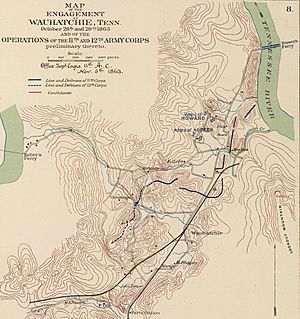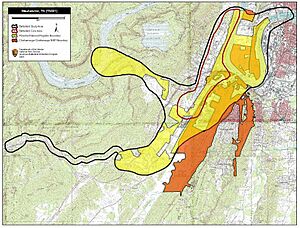Battle of Wauhatchie facts for kids
Quick facts for kids Battle of Wauhatchie |
|||||||
|---|---|---|---|---|---|---|---|
| Part of the American Civil War | |||||||
 Map of the engagement at Wauhatchie, Tenn. by Julius Bien & Co. |
|||||||
|
|||||||
| Belligerents | |||||||
| Commanders and leaders | |||||||
| Joseph Hooker John W. Geary Carl Schurz Adolph von Steinwehr |
Micah Jenkins | ||||||
| Units involved | |||||||
| XI Corps XII Corps |
Jenkins's Brigade, Longstreet's Corps | ||||||
| Casualties and losses | |||||||
| 420 | 408 | ||||||
The Battle of Wauhatchie was a fight during the American Civil War. It happened on October 28–29, 1863, in Tennessee and Georgia. Union soldiers had taken control of Brown's Ferry on the Tennessee River. This opened a way to get supplies to the Union army in Chattanooga. Confederate forces tried to push the Union soldiers away from the ferry. They wanted to close this important supply route again. But the Confederates were defeated. Wauhatchie was one of the few battles in the Civil War that took place at night.
Contents
The Battle of Wauhatchie
Why the Battle Happened
After a tough loss at the Battle of Chickamauga, Union forces went back to Chattanooga, Tennessee. Confederate General Braxton Bragg's army surrounded the city. This was called a siege. The Confederates hoped to starve the Union soldiers into giving up. Bragg's troops were on high ground like Missionary Ridge and Lookout Mountain. From there, they could see the city, the river, and all the Union supply routes.
Confederate soldiers attacked any wagons trying to bring supplies to Chattanooga. This meant the Union army needed a new way to get food. Major General Ulysses S. Grant took charge of the Union forces. His main goal was to get supplies to his army in Chattanooga.
Opening the Supply Line: Brown's Ferry
Grant and another general, George Henry Thomas, started a plan called the "Cracker Line Operation." This plan began on October 26, 1863. Its goal was to open a road to Chattanooga from Brown's Ferry. They also planned to move troops up Lookout Valley. This would help secure another road to Kelley's Ferry.
General William Farrar Smith came up with the idea for the Cracker Line. He was put in charge of setting up a strong position at Brown's Ferry. He had two groups of soldiers, called brigades, for this job.
Early on October 27, some Union soldiers floated on special boats called pontoons. They went around Moccasin Bend to Brown's Ferry. Other Union soldiers took a spot across from the ferry. Once they landed, the first group secured the area. Then, they built a bridge using pontoons across the river. This allowed the second group to cross and join them.
A Confederate officer, Colonel William C. Oates, was guarding the valley. He had his own soldiers and parts of other groups. There was some confusion, and he didn't know where some backup soldiers were. When the Union soldiers surprised them, Oates tried to fight back. But he was badly hurt, and his attack failed. By the time more Confederate soldiers arrived, it was too late. The Union forces were too many and had dug in well.
Hooker's March to Wauhatchie
Meanwhile, Major General Joseph Hooker led three Union groups from Bridgeport. They followed the railroad through a valley. On October 28, Hooker's soldiers reached Lookout Valley. This surprised the Confederate generals, Bragg and James Longstreet. Longstreet had been worried about an attack somewhere else. He had not sent out enough scouts to watch Hooker's movements.
As Hooker's forces moved through Lookout Valley, he sent one group, led by General John W. Geary, to Wauhatchie Station. This was a stop on the railroad. Geary's job was to protect the supply line and the road to Kelley's Ferry. Hooker's troops were spread out. Geary's group was only about 1,500 soldiers. They were left alone, which was a risky move.
The Night Attack
General Bragg told Longstreet to attack the new Union forces. Longstreet noticed Union supply wagons near Wauhatchie. He decided to try and crush Geary's isolated group. He ordered General Micah Jenkins's soldiers to launch a surprise night attack.
One Confederate group would block Hooker from sending help to Geary. Another group, about 1,800 men led by Colonel John Bratton, would attack Wauhatchie Station. The attack was supposed to start at 10:00 p.m. on October 28. But confusion caused a delay until midnight.
Geary and his officers expected an attack. They had sent out guards, called pickets. But the suddenness of the attack still surprised them. Bratton's soldiers attacked from the north. The Union defenders formed a V-shaped line, facing north and east. Geary's own son, who was an artillery officer, was killed in the battle. He died in his father's arms.
When they heard the fighting, Union soldiers near Brown's Ferry quickly got ready. General Hooker ordered General Carl Schurz to march to Wauhatchie Station to help. Another general, Adolph von Steinwehr, got his soldiers moving first.
One of Steinwehr's groups, led by Colonel Orland Smith, was fired on by Confederates. These Confederates were on a 200-foot-high hill that overlooked the road. Smith's soldiers moved east and started climbing the hill. Hooker accidentally sent too many soldiers to fight the Confederates on the hill. This left no one to go help Geary.
The Confederates on the hill were outnumbered. But their high position was strong. In the dark, only Smith's 700 men were directly fighting them. Smith's soldiers attacked several times but were pushed back. Then, the Confederate general on the hill got some wrong information. He decided to pull his soldiers back. Just as they left their dug-in positions, Smith's men rushed over them. They captured some stragglers and scattered a Confederate group that didn't get the order to retreat.
Meanwhile, Geary's soldiers kept fighting hard. They started to run low on bullets. Just as Bratton felt he was about to win, he got a message to retreat. Union reinforcements were arriving behind him. Bratton pulled his soldiers back to Lookout Mountain. Another Confederate group helped cover their retreat. In the Wauhatchie fight, Bratton lost 356 men. Geary's group had 216 casualties.
What Happened Next
A story spread among the Union soldiers. They joked that their mules, scared by the fighting, had stampeded. This made the Confederates think they were being attacked by cavalry, causing them to retreat. The Union soldiers joked that the mules should be made "honorary horses." In truth, the mules only caused a short delay for one Confederate group. But this small pause allowed a Union regiment to fill a gap in their line.
The Union army lost 78 soldiers killed, 327 wounded, and 15 missing. The Confederates reported 34 killed, 305 wounded, and 69 missing. Some reports say Bratton lost 408 men, while another Confederate general lost only 52. Geary reported burying 153 Confederate soldiers and capturing over a hundred prisoners. So, the Confederate losses might have been over 900 men.
The Union army now had its important supply route open. They could get food, weapons, and more soldiers through the "Cracker Line." This victory cleared the way for the bigger Battles for Chattanooga that began on November 23.


